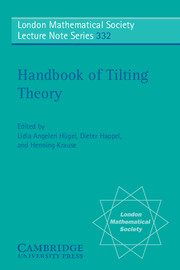Book contents
- Frontmatter
- Contents
- 1 Introduction
- 2 Basic results of classical tilting theory
- 3 Classification of representation-finite algebras and their modules
- 4 A spectral sequence analysis of classical tilting functors
- 5 Derived categories and tilting
- 6 Hereditary categories
- 7 Fourier-Mukai transforms
- 8 Tilting theory and homologically finite subcategories with applications to quasihereditary algebras
- 9 Tilting modules for algebraic groups and finite dimensional algebras
- 10 Combinatorial aspects of the set of tilting modules
- 11 Infinite dimensional tilting modules and cotorsion pairs
- 12 Infinite dimensional tilting modules over finite dimensional algebras
- 13 Cotilting dualities
- 14 Representations of finite groups and tilting
- 15 Morita theory in stable homotopy theory
- Appendix: Some remarks concerning tilting modules and tilted algebras. Origin. Relevance. Future.
3 - Classification of representation-finite algebras and their modules
Published online by Cambridge University Press: 25 May 2010
- Frontmatter
- Contents
- 1 Introduction
- 2 Basic results of classical tilting theory
- 3 Classification of representation-finite algebras and their modules
- 4 A spectral sequence analysis of classical tilting functors
- 5 Derived categories and tilting
- 6 Hereditary categories
- 7 Fourier-Mukai transforms
- 8 Tilting theory and homologically finite subcategories with applications to quasihereditary algebras
- 9 Tilting modules for algebraic groups and finite dimensional algebras
- 10 Combinatorial aspects of the set of tilting modules
- 11 Infinite dimensional tilting modules and cotorsion pairs
- 12 Infinite dimensional tilting modules over finite dimensional algebras
- 13 Cotilting dualities
- 14 Representations of finite groups and tilting
- 15 Morita theory in stable homotopy theory
- Appendix: Some remarks concerning tilting modules and tilted algebras. Origin. Relevance. Future.
Summary
Abstract
We describe how tilting modules are used to classify the representationfinite algebras and their indecomposable modules.
Introduction
Probably the first appearance of tilting modules in representation theory of finite-dimensional algebras was in 1973 the use of reflection functors when Bernstein, Gelfand and Ponomarev [5] reproved Gabriel's classification of the representation-finite hereditary quiver algebras. Dlab and Ringel [18] extended in 1976 the use of reflection functors to arbitrary representation-finite hereditary algebras. Next, the concept of reflection functors has been generalized in 1979 by Auslander, Platzeck and Reiten [2] (they called it ”Coxeter functors without diagrams”), and finally in 1980 by Brenner and Butler [13], who coined the term tilting and gave the first general definition of a tilting module, together with basic properties of tilting functors.
In a time where most people working with representation-finite algebras were knitting Auslander-Reiten sequences, this was a new approach: To study a class of modules which are given by abstract properties. Tilting modules have then been used very successfully by Bongartz [9] and by Happel and Vossieck [26] to find a far-reaching generalization of Gabriel's Theorem to representation-directed algebras, see Theorems 6 and 7 below.
The aim of these notes is to describe this powerful application of tilting theory in the classification of representation-finite algebras, and to add some more details on the representation-infinite case and the classification of tame algebras. These notes arose from two lectures which I gave at the meeting on ’Tilting Theory’ at the Fraueninsel near Munich.
- Type
- Chapter
- Information
- Handbook of Tilting Theory , pp. 15 - 30Publisher: Cambridge University PressPrint publication year: 2007



